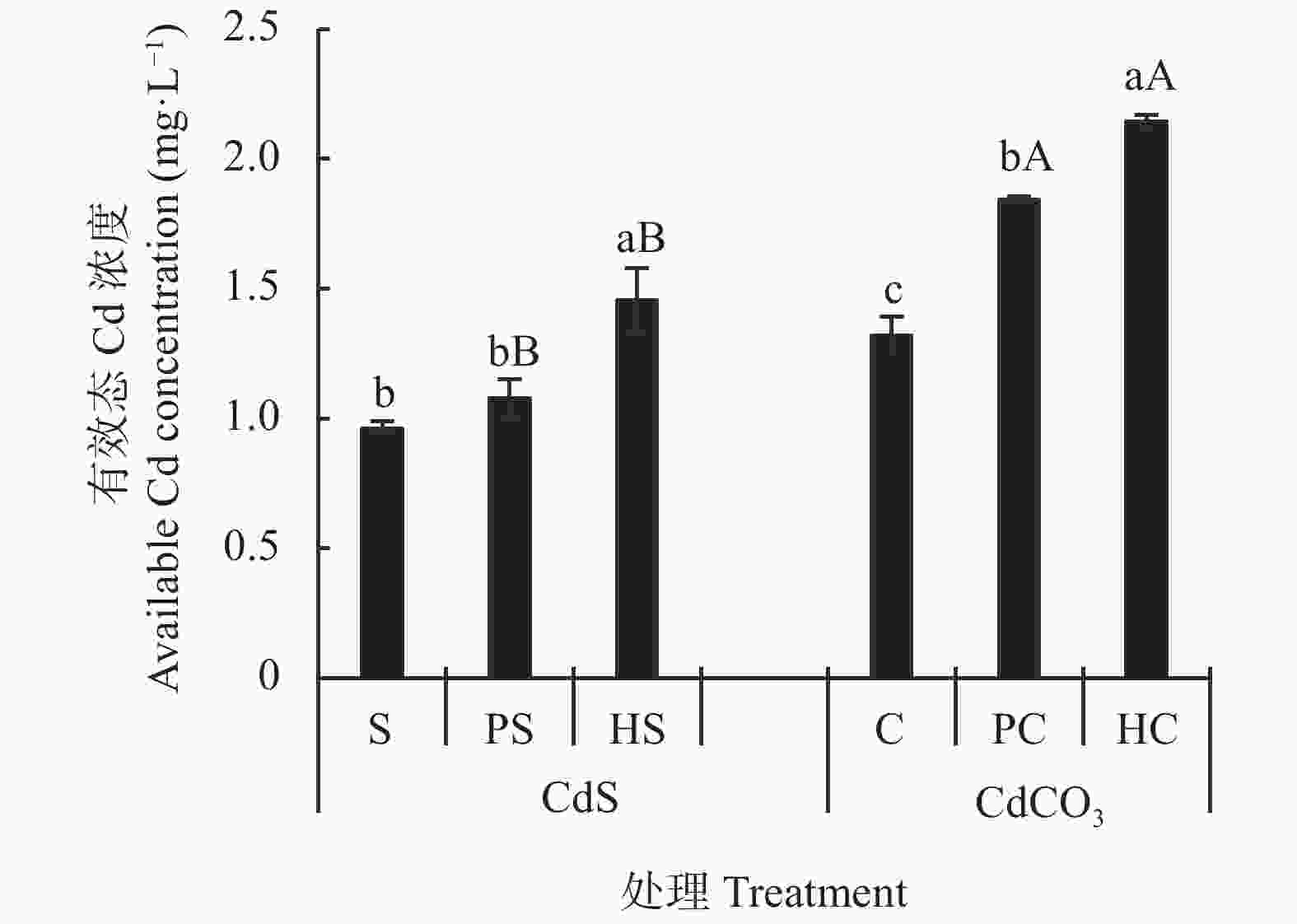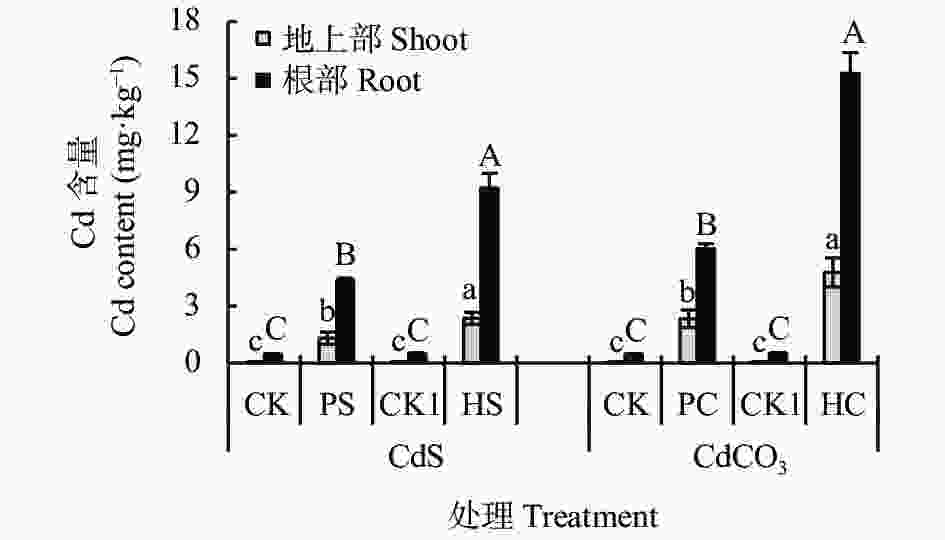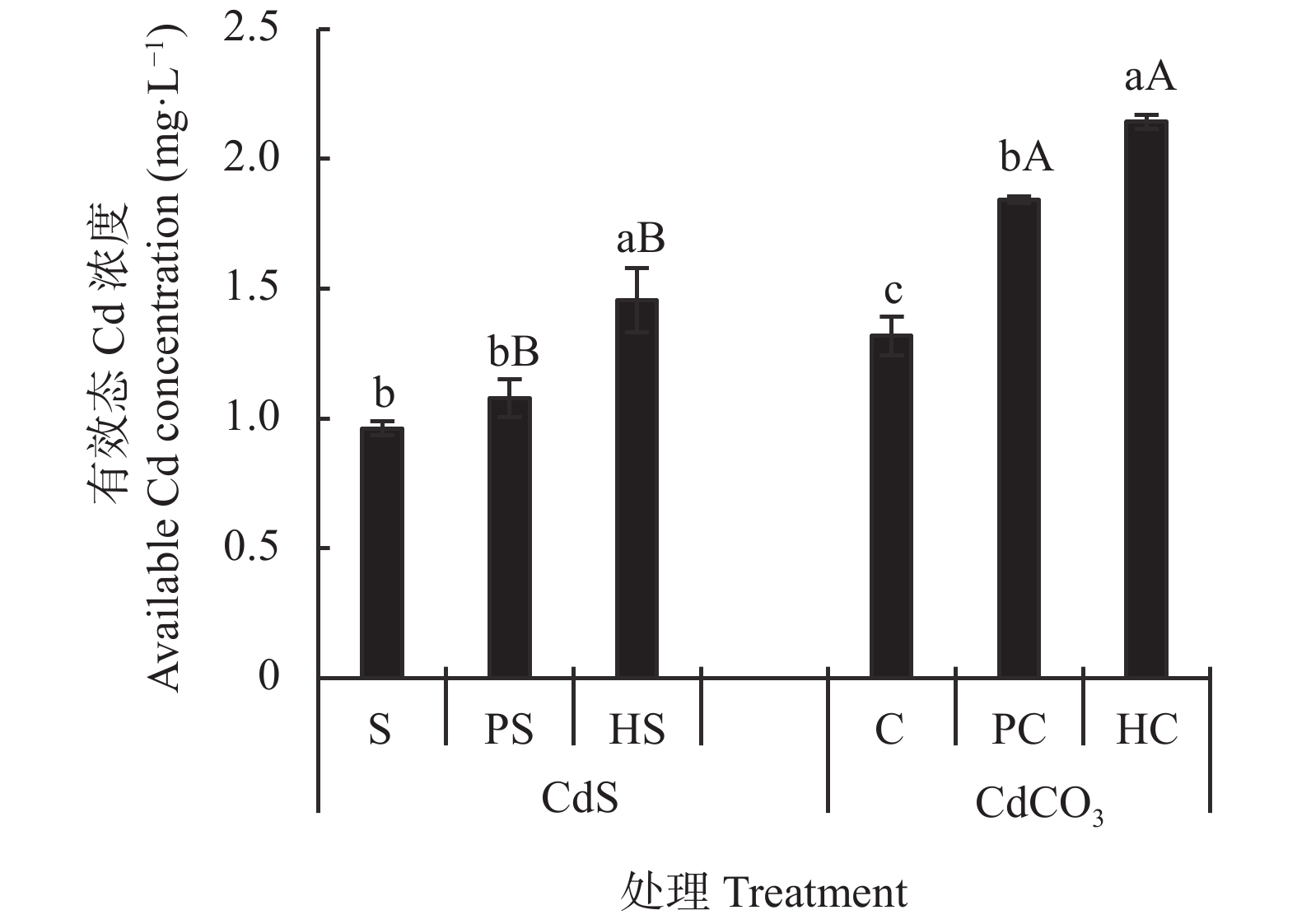Difference in activation and absorption of different insoluble Cd between two tomato varieties with different Cd accumulation
-
摘要: 本研究以两种Cd积累型番茄品种(高积累型‘合作8’, 低积累型‘普罗旺斯’)幼苗为研究对象, 通过水培试验, 研究其对两种难溶态Cd (CdS和CdCO3)的活化效果及吸收差异特征, 并分析两种难溶态Cd对植株的生长效应, 为Cd轻度污染土壤中番茄品种的合理选择提供依据。结果表明: 在活化效果方面, ‘合作8’对难溶态Cd的活化效果显著高于‘普罗旺斯’。CdCO3和CdS处理下高积累型品种‘合作8’使溶液中有效态Cd浓度分别比添加CdCO3和CdS但未种植番茄的处理显著提高62.1%和51.0% (P<0.05); 而低积累型‘普罗旺斯’在CdCO3处理下溶液中有效态Cd浓度比对照增加39.4% (P<0.05), 但在CdS处理下有效Cd浓度变化不明显。在植株Cd吸收方面, CdS和CdCO3处理下‘合作8’地上部与根部Cd含量均显著(P<0.05)高于‘普罗旺斯’, 地上部分别提高80.2%和105.2%, 根部分别提高111.7%和153.8%。与未添加难溶性Cd处理相比, CdS处理下‘普罗旺斯’株高、根长和生物量分别提高15.0%、10.1%和15.5% (P<0.05), 而‘合作8’株高、根长和生物量分别降低5.0%、9.8%和11.3% (P<0.05); 同时, 2种难溶性Cd处理下‘合作8’的株高、根长和生物量均显著低于‘普罗旺斯’(P<0.05)。综上, 高积累型番茄品种对两种难溶态Cd活化的效果显著高于低积累型番茄品种, 显著提高了Cd的生物有效性, 高积累型品种对难溶态CdS和CdCO3的吸收也显著高于低积累型品种, 使高积累型番茄植株生长受到了显著抑制。Abstract: Soil Cd pollution is becoming increasingly hazardous, and the effective state of Cd largely affects its biological effectiveness. The difference in the activation of insoluble Cd directly affects the uptake and accumulation of Cd in vegetables, and there are obvious differences in the uptake and accumulation capacity of different tomato varieties for Cd. However, the difference in the activation of Cd insoluble forms of CdS and CdCO3 by different Cd-accumulation tomato varieties remains unclear. Therefore, in this study, the seedlings of two tomato varieties with different Cd-accumulation capacity (high-Cd-accumulation type ‘Cooperative 8’ and low-Cd-accumulation type ‘Provence’) were used as research objects. The activation effects and absorption differences of two types of insoluble Cd (CdS and CdCO3) were studied through hydroponic experiments, and the effects of two types of insoluble Cd on plant growth were analyzed. The purpose of this study was to provide a theoretical basis for reducing the risk of tomato Cd pollution, ensuring the safety of tomato production and reasonable selection of tomato varieties. The results showed that the activation effect of CdCO3 and CdS of high-Cd-accumulation type ‘Cooperative 8’ significantly increased the available Cd concentration in solution by 62.1% and 51.0% compared to the Cd concentration in non-planting tomato solution (P<0.05), while the low-Cd-accumulation type ‘Provence’ significantly promoted the dissolution of insoluble CdCO3 by 39.4% (P<0.05). However, the activation of insoluble CdS was not significant, and the activation of insoluble Cd by ‘Cooperative 8’ was significantly higher than that of ‘Provence’. In terms of plant Cd uptake, the shoot and root Cd contents of ‘Cooperative 8’ were significantly higher than those of ‘Provence’ under insoluble CdS treatment, which increased by 80.2% and 111.7% (P<0.05), respectively. Under insoluble CdCO3 treatment, the shoot and root Cd contents of ‘Cooperative 8’ were 105.2% and 153.8% higher than those of ‘Provence,’ respectively (P<0.05). Compared with the treatment without insoluble Cd, the treatment with insoluble CdS increased the plant height, root length, and biomass of ‘Provence’ by 15.0%, 10.1%, and 15.5% (P<0.05), respectively, while decreased the plant height, root length, and biomass of ‘Cooperative 8’ by 5.0%, 9.8% and 11.3% (P<0.05), respectively. Plant height, root length, and biomass of ‘Cooperative 8’ were significantly lower than those of ‘Provence’ under the two insoluble Cd treatments (P<0.05). In conclusion, the high-Cd-accumulation variety of tomato promoted the activation of the two insoluble Cd forms significantly more than the low-Cd-accumulation variety of tomato, and the bioeffectiveness of Cd was significantly improved. The absorption and accumulation of available Cd by high-Cd-accumulation tomato variety were significantly higher than those of low-Cd-accumulation tomato variety, which significantly inhibited the growth of tomato plants with high accumulation. However, CdS treatment had a significant stimulating effect on the growth of the low-Cd-accumulation variety ‘Provence’.
-
Key words:
- Tomato /
- Cd accumulation type /
- Insoluble Cd /
- Cd activation /
- Cd absorption
-
图 1 不同番茄品种对两种难溶性Cd处理溶液中有效态Cd含量的影响
S和C分别表示CdS和CdCO3溶液, PS和PC分别表示种植低积累型番茄品种‘普罗旺斯’的CdS和CdCO3溶液, HS和HC为种植高积累型番茄品种‘合作8’的CdS和CdCO3溶液。不同小写字母表示相同Cd种类不同处理间差异显著(P<0.05), 不同大写字母表示同一处理不同Cd种类差异显著(P<0.05)。In treatments, S and C are the solutions of CdS and CdCO3; PS and PC mean planting low-Cd-accumulation variety of tomato in CdS and CdCO3 solutions, HS and HC mean planting high-Cd-accumulation variety of tomato in CdS and CdCO3 solutions. Different lowercase letters indicate significant differences among treatments of the same Cd type (P<0.05). Different capital letters indicate significant differences between two Cd types for the same treatment (P<0.05).
Figure 1. Concentrations of available Cd in solution of different insoluble Cd planting with different tomato varieties
图 2 不同番茄品种在两种难溶性Cd处理溶液中地上部和根部的Cd含量
处理CK和CK1分别表示不添加Cd种植低积累型番茄品种‘普罗旺斯’和不添加Cd种植高积累型番茄品种‘合作8’; PS和PC分别表示种植低积累型番茄品种‘普罗旺斯’的CdS和CdCO3溶液, HS和HC为种植高积累型番茄品种‘合作8’的CdS和CdCO3溶液。不同小写字母表示相同Cd种类不同处理间地上部Cd含量差异显著(P<0.05); 不同大写字母表示相同Cd种类不同处理间根部Cd含量差异显著(P<0.05)。In treatments, CK and CK1 are the planting with low-accumulation variety of tomato without adding Cd and planting with high-accumulation variety of tomato without adding Cd. PS and PC denote CdS and CdCO3 solutions for low accumulating tomato variety ‘Provence’, respectively, while HS and HC are CdS and CdCO3 solutions for high accumulating tomato variety ‘Cooperative 8’. Different lowercase letters indicate significant differences (P<0.05) in above-ground Cd content among treatments of the same Cd species; different capital letters indicate significant differences (P<0.05) in root Cd content among treatments of the same Cd species.
Figure 2. Cd contents in shoots and roots of different tomato varieties planting in solution of different insoluble forms of Cd
图 3 不同番茄品种对两种难溶性Cd处理溶液中植株幼苗生长指标的影响
处理CK和CK1分别表示不添加Cd种植低积累型番茄品种‘普罗旺斯’和不添加Cd种植高积累型番茄品种‘合作8’; PS和PC分别表示种植低积累型番茄品种‘普罗旺斯’的CdS和CdCO3溶液, HS和HC为种植高积累型番茄品种‘合作8’的CdS和CdCO3溶液。不同小写字母表示相同Cd种类不同处理间差异显著(P<0.05)。In treatments, CK and CK1 are the planting with low-accumulation variety of tomato without adding Cd and planting with high-accumulation variety of tomato without adding Cd. PS and PC denote CdS and CdCO3 solutions for low accumulating tomato variety ‘Provence’, respectively, while HS and HC are CdS and CdCO3 solutions for high accumulating tomato variety ‘Cooperative 8’. Different lowercase letters indicate significant differences among different treatments for the same Cd type (P<0.05).
Figure 3. Growth indicators in solution of different insoluble Cd planting with different tomato varieties
表 1 两种难溶态Cd处理下番茄植株生长指标比无污染对照的变化幅度
Table 1. Increase range of growth indexes in two tomato varieties under different treatments
处理
Treatment株高
Pant height根长
Root length生物量
Biomass% PS 15.0±1.1a 10.1±0.9a 15.5±2.6a HS −5.0±0.5c −9.8±2.5c −11.3±0.3c PC 0.7±0.9b −0.8±1.6b −1.6±0.8b HC −8.8±1.1d −19.6±2.3d −25.5±3.4d 处理PS和HS分别为在CdS溶液中种植低积累型番茄品种‘普罗旺斯’和高积累型番茄品种‘合作8’, 处理PC和HC分别为在CdCO3溶液中种植低积累型番茄品种‘普罗旺斯’和高积累型番茄品种‘合作8’。同列不同小写字母表示处理间差异显著(P<0.05)。Treatments PS and HS are planting low-Cd-accumulation and high-Cd-accumulation varieties of tomato in CdS solution, respectily. Treatments PC and HC are planting low-Cd-accumulation and high-Cd-accumulation varieties of tomato in CdCO3 solution, respectively. Different lowercase letters in the same column indicate significant differences among different treatments (P<0.05). -
[1] 环境保护部, 国土资源部. 全国土壤污染状况调查公报[J]. 中国环保产业, 2014, 36(5): 10−11Ministry of Environmental Protection, Ministry of Land and Resources. National Soil Pollution Survey Bulletin[J]. China Environmental Protection Industry, 2014, 36(5): 10−11 [2] WHITE P J, HAMMOND J P. The Ecophysiology of Plant-Phosphorus Interactions[M]. Dordrecht: Springer Netherlands, 2008 [3] DAI Z Y, SHU W S, LIAO B, et al. Intraspecific variation in cadmium tolerance and accumulation of a high-biomass tropical tree Averrhoa carambola L.: implication for phytoextraction[J]. Journal of Environmental Monitoring: JEM, 2011, 13(6): 1723−1729 doi: 10.1039/c1em10054h [4] JIAO W, OUYANG W, HAO F H, et al. Geochemical variability of heavy metals in soil after land use conversions in Northeast China and its environmental applications[J]. Environmental Science Processes & Impacts, 2014, 16(4): 924−931 [5] 周贵宇, 姜慧敏, 杨俊诚, 等. 几种有机物料对设施菜田土壤Cd、Pb生物有效性的影响[J]. 环境科学, 2016, 37(10): 4011−4019ZHOU G Y, JIANG H M, YANG J C, et al. Effects of different organic materials on bio-availability of Cd, Pb in a contaminated greenhouse soil[J]. Environmental Science, 2016, 37(10): 4011−4019 [6] BOLAN N, KUNHIKRISHNAN A, THANGARAJAN R, et al. Remediation of heavy metal(loid)s contaminated soils — To mobilize or to immobilize?[J]. Journal of Hazardous Materials, 2014, 266: 141−166 doi: 10.1016/j.jhazmat.2013.12.018 [7] XIN J L, HUANG B F, DAI H W, et al. Roles of rhizosphere and root-derived organic acids in Cd accumulation by two hot pepper cultivars[J]. Environmental Science and Pollution Research International, 2015, 22(8): 6254−6261 doi: 10.1007/s11356-014-3854-z [8] 王小敏, 刘文菊, 李博文, 等. 巨大芽孢杆菌与胶冻样类芽孢杆菌对土壤镉的活化效果研究[J]. 水土保持学报, 2013, 27(6): 83−88 doi: 10.3969/j.issn.1009-2242.2013.06.017WANG X M, LIU W J, LI B W, et al. Effect of Bacillus megaterium and Paenibacillus kribbensis on availability of soil Cd[J]. Journal of Soil and Water Conservation, 2013, 27(6): 83−88 doi: 10.3969/j.issn.1009-2242.2013.06.017 [9] 杨仁斌, 曾清如, 周细红, 等. 植物根系分泌物对铅锌尾矿污染土壤中重金属的活化效应[J]. 农业环境保护, 2000, 19(3): 152−155YANG R B, ZENG Q R, ZHOU X H, et al. The activated impact of plant root exudates on heavy metals in soils contaminated by tailing of lead-zinc ore[J]. Agro-Environmental Protection, 2000, 19(3): 152−155 [10] TIAN S K, LU L L, YANG X E, et al. The impact of EDTA onlead distribution and speciation in the accumulator Sedum alfredii by synchrotron X-ray investigation[J]. Environmental Pollution, 2011, 159(3): 782−788 doi: 10.1016/j.envpol.2010.11.020 [11] CHEN J, JIN P, HUANG S M, et al. Cabbage cultivars influence transfer and toxicity of cadmium in soil-Chinese flowering cabbage Brassicacampestris-cutworm Spodoptera litura larvae[J]. Ecotoxicology and Environmental Safety, 2021, 213: 112076 doi: 10.1016/j.ecoenv.2021.112076 [12] LI X Y, PENG P Q, LONG J, et al. Plant-induced insoluble Cd mobilization and Cd redistribution among different rice cultivars[J]. Journal of Cleaner Production, 2020, 256: 120494 doi: 10.1016/j.jclepro.2020.120494 [13] 高夕彤, 李硕, 贾娟, 等. 不同番茄品种对镉胁迫的耐抗性差异研究[J]. 华北农学报, 2018, 33(2): 169−176 doi: 10.7668/hbnxb.2018.02.024GAO X T, LI S, JIA J, et al. Study on resistance of different tomato varieties to cadmium stress[J]. Acta Agriculturae Boreali-Sinica, 2018, 33(2): 169−176 doi: 10.7668/hbnxb.2018.02.024 [14] 袁波, 傅瓦利, 蓝家程, 等. 菜地土壤铅、镉有效态与生物有效性研究[J]. 水土保持学报, 2011, 25(5): 130−134YUAN B, FU W L, LAN J C, et al. Study on the available and bioavailability of lead and cadmium in soil of vegetable plantation[J]. Journal of Soil and Water Conservation, 2011, 25(5): 130−134 [15] 姜理英, 杨肖娥, 石伟勇, 等. 植物修复技术中有关土壤重金属活化机制的研究进展[J]. 土壤通报, 2003, 34(2): 154−157 doi: 10.3321/j.issn:0564-3945.2003.02.018JIANG L Y, YANG X E, SHI W Y, et al. Activation of soil heavy metals for phytoremediation[J]. Chinese Journal of Soil Science, 2003, 34(2): 154−157 doi: 10.3321/j.issn:0564-3945.2003.02.018 [16] 范洪黎, 周卫. 镉超富集苋菜品种(Amaranthus mangostanus L.)的筛选[J]. 中国农业科学, 2009, 42(4): 1316−1324 doi: 10.3864/j.issn.0578-1752.2009.04.023FAN H L, ZHOU W. Screening of amaranth cultivars (Amaranthus mangostanus L.) for cadmium hyperaccumulation[J]. Scientia Agricultura Sinica, 2009, 42(4): 1316−1324 doi: 10.3864/j.issn.0578-1752.2009.04.023 [17] 国家卫生和计划生育委员会. 食品安全国家标准 食品中镉的测定: GB 5009.15—2014[S]. 北京: 中国标准出版社, 2015National Health and Family Planning Commission. National Standard for Food Safety Determination of Cadmium in Food: GB 5009.15—2014[S]. Beijing: China Standards Press, 2015 [18] 闫仁俊. 玉米与超富集植物间作条件下Cd富集效应及其机理[D]. 北京: 中国农业科学院, 2020YAN R J. Study on the effect and mechanism of Cd enrichment under the condition of intercropping of mazie and hyperaccumulation[D]. Beijing: Chinese Academy of Agricultural Sciences, 2020 [19] 吴志超. 高低镉积累油菜品种筛选及其生化机制研究[D]. 武汉: 华中农业大学, 2015WU Z C. Screening of high/low cadmium accumulation Brassica napus cultivars and research on the biochemical mechanisms[D]. Wuhan: Huazhong Agricultural University, 2015 [20] 龚玉莲, 杨中艺. 蕹菜不同镉积累品种的根际土壤化学特征[J]. 应用生态学报, 2014, 25(8): 2377−2384GONG Y L, YANG Z Y. Chemical characteristics of the rhizosphere soil of water spinach cultivars differing in Cd accumulation[J]. Chinese Journal of Applied Ecology, 2014, 25(8): 2377−2384 [21] 邹素敏. 不同镉积累型叶用芥菜品种镉吸收与转运生理机制研究[D]. 武汉: 华中农业大学, 2017ZOU S M. Cadmium uptake and transport mechanisms of leaf mustard cultivars with different cadmium accumulation abilities[D]. Wuhan: Huazhong Agricultural University, 2017 [22] 肖亚涛. 冬小麦籽粒镉低积累品种的生产特性及其低积累机制研究[D]. 北京: 中国农业科学院, 2016XIAO Y T. Production characteristics and mechanism of low accumulation in winter wheat with low cadmium accumulation in grain[D]. Beijing: Chinese Academy of Agricultural Sciences, 2016 [23] 魏佳, 李取生, 徐智敏, 等. 多种有机酸对土壤中碳酸镉的活化效应[J]. 环境工程学报, 2017, 11(9): 5298−5306 doi: 10.12030/j.cjee.201612218WEI J, LI Q S, XU Z M, et al. Mobilization effects of various organic acids on cadmium carbonate in soil[J]. Chinese Journal of Environmental Engineering, 2017, 11(9): 5298−5306 doi: 10.12030/j.cjee.201612218 [24] 廉梅花. 根际土壤中重金属的活化因素及作用机理研究[D]. 沈阳: 东北大学, 2016LIAN M H. Study on the activating factors and mechanisms of heavy metals in rhizosphere soil[D]. Shenyang: Northeastern University, 2016 [25] 苏徳纯, 黄焕忠, 张福锁. 印度芥菜对土壤中难溶态Cd的吸收及活化[J]. 中国环境科学, 2002, 22(4): 342−345 doi: 10.3321/j.issn:1000-6923.2002.04.014SU D C, HUANG H Z, ZHANG F S. The absorption and activation of insoluble Cd in soil by Indian mustard (Brassica juncea)[J]. China Environmental Science, 2002, 22(4): 342−345 doi: 10.3321/j.issn:1000-6923.2002.04.014 [26] 刘文菊, 张西科, 张福锁. 根分泌物对根际难溶性镉的活化作用及对水稻吸收、运输镉的影响[J]. 生态学报, 2000, 20(3): 448−451 doi: 10.3321/j.issn:1000-0933.2000.03.018LIU W J, ZHANG X K, ZHANG F S. The mobilization of root exudates on CdS in rice rhizosphere and their effect on Cd uptake and transport[J]. Acta Ecologica Sinica, 2000, 20(3): 448−451 doi: 10.3321/j.issn:1000-0933.2000.03.018 -






 下载:
下载:





